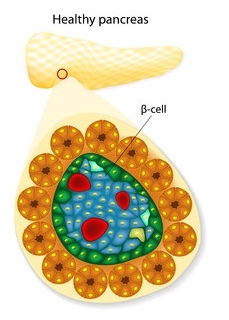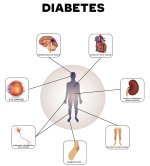What is Normal Blood Sugar?

Here we answer the question, “What is Normal Blood Sugar”? …and how normal blood sugar is maintained by your body.
You’d think that this question is simple, but in fact it is a bit more complicated than you may initially assume. Health experts do not currently agree to the question what is normal blood sugar.
For example, the International Diabetes Federation, defines a normal blood sugar range for people without diabetes and who are not fasting as being between 82 mg/dL (4.4 mmol/L) and 110 mg/dL (6.1 mmol/L) with 82 mg/dl being optimal.
The American Diabetes Association answers the question of what is normal blood sugar quite differently. They suggest the following normal blood sugar targets for most non-pregnant adults with diabetes::
- 70-130mg/dL before a meal
- less than 180 mg/dL within 2 hours after a meal
The National Institute for Clinical Excellence (NICE) recommends the following blood glucose ranges for healthy individuals
- Normal blood glucose level: about 72 mg/dL (4 mmol/L)
- 72 - 106 mg/dL (4.0 to 5.9 mmol/L) before a meal
- Less than 140 mg/dL (under 7.8 mmol/L) 2 hours after meals
But wait, the question “What is normal blood sugar” gets even more complicated! Newer research indicates that truly normal blood sugar levels may be significantly lower than those commonly recommended by doctors. A 2006 study conducted by Dr. J.S. Christiansen found that the blood sugar in healthy people rarely goes over 125 mg/dL (6.9 mmol/L), even after a high carbohydrate breakfast. The results of this study suggest that the following are normal blood sugar levels:
- 80-85 mg/dL (4.4 - 4.7 mmol/L) before a meal
- 100 mg/dL (5.6 mmol/L) within 1-1/4 hour after eating
- 85 mg/dL (4.7 mmol/L) within 1-3/4 of an hour after eating
Why is important to have normal blood sugar?
The simple answer to this is that there are a host of health problems caused by having high blood sugar. For example if your fasting blood sugar levels consistently stay above 126 mg/dl (7mmol/L) then your blood vessels and organs can be damaged. Learn more about the dangers of having high blood sugar levels (high blood sugar level).
How does your body maintain normal blood sugar?
To answer this question, you need to understand how your body regulates your blood sugar. Normally, there is only about a teaspoon worth of glucose in your bloodstream.
Glucose is the sugar we refer to as blood sugar. It is different from sucrose (granulated beet or cane sugar) and fructose (fruit sugar). Granulated cane sugar is, in fact, about 50% glucose and 50% fructose.
Simple carbohydrates, like white rice, potatoes and white bread, are broken down very quickly by your digestion and converted into glucose (about 5 teaspoons worth per slice of bread for example).
Say you eat a slice of bread and nothing else. The 5 teaspoons worth of glucose in the bread will all be released into your bloodstream very quickly. This much glucose would be toxic and cause you to go into a coma if it were not for insulin.
Insulin plays a major role in regulating your blood sugar. Produced by beta cells in the Islets of Langerhans inside of your pancreas (see picture above), insulin is responsible for shepherding glucose out of your blood and into your brain and muscle cells where it is used as energy or into fat cells where it is stored. You liver also stores a certain amount in the form of glycogen which it releases as needed if your blood sugar gets too low.
The cells of your body, especially your brain cells, constantly need energy to to their job. For this reason, your beta cells are continually making insulin. A continuous trickle, called Basal Insulin Release, is released in small pulses 24 hours a day. Extra supply is stored as granules where it can be released in larger burst when you eat. These bursts are called first and second phase insulin releases.
The first-phase release, comprised of insulin that was stored as granules, happens shortly after you start eating and is supposed to prevent your blood sugar from exceeding 125 mg/dL. The amount released is thought to be based on what was needed to process the glucose during your last couple meals.
Here is how glucose is dealt with by your body when you eat:
- Brain and muscle cells are fed
- Liver tops off its glycogen stores
- The rest is pushed into fat cells
The second-phase release, comprised of insulin that is secreted by beta cells (as opposed to stored as granules) happens between 45 and 90 minutes after you start eating. A second phase release is basically a clean-up release that isn’t necessary unless your blood sugar levels are still above 100 mg/dL. The second phase release will continue until your blood sugar is back down to around 80 mg/dL.
How can you find out if you have normal blood sugar?
You can go to your doctors office and have our blood sugar tested. For many reasons outlined above, we recommend that you have a glucose tolerance test to determine if your body is having trouble maintaining your blood glucose levels.
What is Normal Blood Sugar?
As you can see, the question of what is normal blood sugar is not as clear cut as you likely thought. However, we hope we have provided you a starting place to determine if you have blood sugar levels that you are happy with.
More Information
- Top 3 Symptoms of High Blood Sugar
- Reasons You May be Experiencing Symptoms of High Blood Sugar
- All About High Blood Sugar
- All About Low Blood Sugar
- All About Normal Blood Sugar
- All About Fasting Blood Sugar



New! Facebook Comments
What do you think? Share your thoughts below...